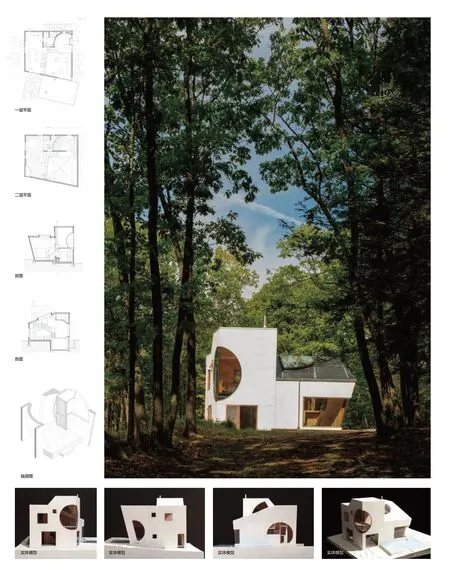过去的“内部”住宅美国纽约,莱茵贝克
2020-11-07StevenHoll,DimitraTsachrelia,projectarchitect等
设计范围:招待所/艺术家住宅
设计单位:史蒂文·霍尔建筑师事务所
设计团队:Steven Holl (design architect),Dimitra Tsachrelia (design architect, project architect), Yuliya Savelyeva, Ruoyu Wei(project team)
结构工程:Robert Silman Associates
用地面积:28 英亩
建筑面积:918 平方呎
时间: 2014年 - 2016年
Program: Guest House / Artist Residence
Architect: Steven Holl Architects
Design Team: Steven Holl (design architect), Dimitra Tsachrelia (design architect, project architect), Yuliya Savelyeva, Ruoyu Wei (project team)
Structural Engineer: Robert Silman Associates
Site Area: 28 acres
Floor Area (Square Feet): 918sf
Year: 2014 - 2016
过去的“内部”住宅是对空间语言的探索,旨在讨论空间和特定地点能量的共鸣——同时质疑当前建筑设计和商业化的陈词滥调。过去的“内部”住宅是从 2014年 6 月以来,斯蒂文霍尔建筑事务所的“内”研究开发项目的一个具象化体现。
在二十八英亩(约 11 公顷)的森林和岩石的场地上,建立了被称为“T2 保护区”的实验拓扑景观区。原本被划分为五个郊区房屋的地块被合并成一个自然保护景观。整个建筑压缩成 918 平方英尺(约 85平方米),建在二十八英亩(约 11 公顷)的原始郊区土地上,建筑作为现代主义郊区的住宅“在大地上无限的蔓延”的替代。过去的“内部”住宅是压缩和内部体块的体现。
建筑的体量是由球体和长方体梯形体相交而形成的内部空间。在入口门廊即可感受到球面交叉的几何结构;根据建筑体积雕刻出的木制球体时刻静候着访客的到来。截面的变化使内部空间极富动态,不同的几何体重叠在一起,围绕一个主体量通向第二层,厨房位于中心,潜移默化地改变着空间使用模式。虽然没有卧室,但可提供5 个个人空间。建筑采用地热供暖,代替了化石燃料。电力来自太阳,而不是电网。将 SoloPower 薄膜光伏电池连接到 Sonnen 电池储能系统,使建筑实现能源独立。所有的灯具都是用聚乳酸玉米淀粉基生物塑料 3D 打印的。玻璃和木材都来自当地。
建筑几乎完全由建筑工人使用原材料建造而成,采用了桃花心木实木门窗框和门框,以及桃花心木楼梯和桦木胶合板墙。没有用到任何石膏板。球形交叉空间也是通过弯曲薄木制成的。所有天然的青木油和胶合板内饰无处不体现着贫穷艺术主义的用材和日式侘寂的精神。
The Ex of In House explores a language of space, aimed at inner spatial energy strongly bound to the ecology of the place - questioning current clichés of architectural language and commercial practice.The house is a built manifestation of the research and development project Explorations of "IN" under development at Steven Holl Architects since June 2014.
On twenty-eight acres of forested rock outcropping, the site named ‘T2 reserve’ has been established as an experimental topological landscape.Slated to be a subdivision with five suburban house plots,the site was joined into one natural preserved landscape.As a compressed form of 918 square feet on a site of twenty-eight preserved rural acres, the house serves as an alternative to modernist suburban houses that “sprawl in the landscape”.Instead, the Ex of In is a house of compression and inner voids.
The house’s geometry is formed from spherical spaces intersecting with tesseract trapezoids intended as a catalyst of volumetric inner space.The geometry of the spherical intersections begins to be felt at the entry porch; an orb of wood carved out of the house volume welcomes the entrant.The shift in section of the house alters internal space with vertical dynamic spatial overlap.Situated around one main volume, open to the second level, with the kitchen placed in the center, alternative use patterns are created.There are zero bedrooms, yet the house can sleep five.Instead of fossil fuel, the house is heated geothermally.Instead of grid power, the house has electricity from the sun.Thin film SoloPower photovoltaic cells are connected to a Sonnen battery energy storage system, allowing the house to be energy independent.All light fixtures are 3D printed in PLA cornstarch-based bioplastic.Glass and wood are locally sourced.
The house was made almost entirely from raw materials by the builders, crafting solid mahogany window and door frames, a mahogany stair and birch plywood walls.There is no use of sheetrock.The spherical intersection space was also crafted in curved, thin wood layers.All natural oiled wood and plywood interior finishes are part of the arte povera materiality and economy of this place of wabi-sabi.


